|
‘Aussie Eight’
Spitfire Mk.VIII in Australian Service
Limited Edition Dual Combo
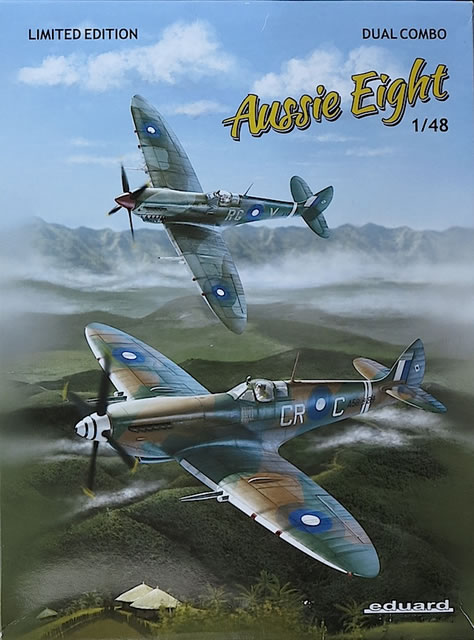
Eduard, 1/48 scale
S u m m a r y : |
Catalogue Number: |
Eduard Kit No.1188 – ‘Aussie Eight’ Spitfire Mk.VIII in Australian Service – Limited Edition/Dual Combo |
Scale: |
1/48 |
Contents & Media: |
Approximately 420 grey plastic parts (134 unused); 34 clear plastic parts (14 unused); two frets of pre-painted photo-etched brass; 16 grey resin parts; one sheet of pre-cut canopy masks; one decal sheet of national insignia; one decal sheet of markings for 31 schemes on 29 different aircraft; one small sheet of updated and/or corrected decals for five of the marking options, with an accompanying explanatory note; two sheets of airframe stencil decals and an A4 greyscale, four view stencil placement guide; ‘Aussie Eight’ book by Peter Malone (104 pages, A4 format with English text, black and white period photographs and full colour plans and profiles); 12 page A4 assembly instruction booklet; 32 page full colour painting and marking guide with four view drawings of all featured aircraft; 42 x 30 cm (16.5 x 12 inch) full colour, frameable print of one of the kit marking options. |
Price: |
USD $125.00 available online from Eduard’s website
Also available from specialist hobby retailers worldwide. |
Review Type: |
First Look |
Advantages: |
Excellent base kits that are further improved by the inclusion of photo-etched and resin details; superb decals; enormous range of marking options; Peter Malone’s ‘Aussie Eight’ book is unique to this boxing and arguably the definitive reference on Australian Mk.VIIIs. |
Disadvantages: |
|
Conclusions: |
Eduard’s ‘Aussie Eight’ package is almost beyond superlatives, and an essential purchase for anyone interested in modelling Spitfires, RAAF subjects, or both. Get yours before it inevitably sells out. Very highly recommended. |
Reviewed by
Brad Fallen

Eduard's 1/48 scale F6F-5 Early ProfiPACK is available online from Squadron.com
Perhaps more than any other aircraft, the Spitfire Mk.VIII reflects the fortunes of the Royal Australian Air Force in the final 18 months of the Pacific war. It was ordered from Britain when northern Australia was being regularly pounded by Japanese air raids – Darwin was bombed 64 times, and Broome and other centres 33 more. But the month that the first Mk.VIII arrived, November 1943, also marked the last bombing raid. And the Mk.VIII’s first victory in RAAF service – a Mitsubishi Dinah destroyed by Flight Lieutenant D.M. Gossland in A58-312 on 20 July 1944 – was the last Japanese aircraft shot down over Australia.
Mk.VIIIs achieved only three more victories before the war ended. This was partly because Japanese air power was declining, but also because inter-Allied politics saw the RAAF Spitfire squadrons given mopping up and containment duties well behind the main Pacific frontline. Even the major operations in which they were used, such as the invasion of Borneo, were of dubious strategic benefit. This led to morale problems as pilots believed the ground attack missions they were being ordered to conduct were irrelevant to the outcome of the war.
The Mk.VIII was not retained in RAAF service much beyond war’s end. In 1948 a few airframes were refitted with old Spitfire Mk.Vc engines and propellers and used by the Royal Australian Navy as ground handling aids.
Overall, Australia received 410 Spitfire Mk.VIIIs, although a number of these went directly into storage. This includes the last Mk.VIII taken on charge, A58-758, which is currently operated by the Temora Aviation Museum. I’ve seen A58-758 flying a number of times, most recently in February 2014 as it made a fast, low speed pass over the museum en route to the Centenary of Military Aviation Airshow in Melbourne. It’s a beautiful thing.
Eduard first released its 1/48 Spitfire Mk.VIII kit as a Profipack boxing in March 2015. In reviewing the kit later that month, Brett Green summed up that
Eduard's Mk.IX kits were the best Spitfires in 1/48 scale upon their release, and they still are today….[They] all boast a high degree of accuracy, superb surface textures, excellent detail and modeller-friendly parts breakdown.
This new Spitfire Mk.VIII is equally good. It would have been easy to ignore some of the subtler differences between the Mk.IX and Mk.VIII, but Eduard has gone the whole nine yards with their brand new fuselage and wings depicting the unique attributes of this later variant….These Spitfires showcase Eduard at the very top of their game.
Amongst this kit’s six marking options are decals for one RAAF machine – A58-602, flown by Wing Commander Bobby Gibbes in 1944-45. Gibbe’s aircraft is a colourful but predictable choice for a RAAF Mk.VIII, and I hoped that Eduard might produce a Limited Edition RAAF boxing of the kit along the lines of their ‘Longest Day’ release of the Mk.IX.
Well, in September this year they did just this, and in a most spectacular way.
Eduard’s Limited Edition Dual Combo ‘Aussie Eight’ boxing is a big release, literally. The 39 x 30cm (15 ¾ x 12 inch) box is adorned with beautiful art of Gibbe’s A58-602 and Group Captain Clive Caldwell’s A58-484 flying side by side over the New Guinea Highlands. This art also features on the front covers of the assembly instructions, painting and marking guide and Peter Malone’s book.

Inside the box are the following items:
- Plastic parts for two 1/48 Spitfire Mk.VIII kits. Brett has already described the Mk.VIII plastic in his initial review, so I won’t dwell on it here other than to say both the grey and clear parts are exceptionally well moulded and on a par with the Eduard Mk.IX kits I have examined previously. As with all Eduard Spitfire kits, you will end up with plenty of parts for the spares box – over 130 in fact!
- Two frets of photo-etched brass (one for each kit) containing painted and unpainted parts, mostly but not exclusively for the cockpit.
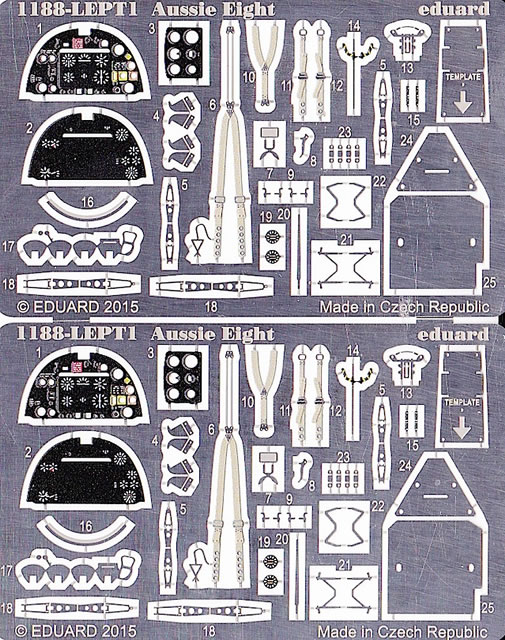
- Resin (Brassin) Z-Block 4-spoke mainwheels. Eduard’s website suggests that two pairs of these wheels are included in the box (as you would expect in a release containing two kits) but the review box contained four pairs, which again is handy in terms of spares. All of the wheels are perfectly cast and engineered for easy cleanup and painting; their only peculiarity is the now well-known misspelling of ‘Dunlop’ on the sidewalls.
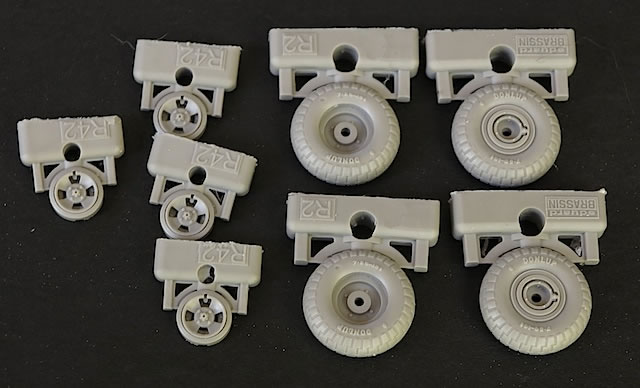
- A small sheet of pre-cut tape canopy masks, which will make this otherwise tricky painting exercise much easier.
- A 12-page black-and-white A4 instruction booklet that calls out assembly in Eduard’s usual clearly illustrated steps. Colours are listed by Gunze Sangyo paint number and optional or aircraft-specific parts are prominently labeled.
- A 32-page full colour A4 painting and marking guide that provides four view illustrations of 31 schemes on 29 aircraft. Some of these machines, particularly those based in the Netherlands East Indies in 1944-45, were a patchwork of colours as a result of weathering and overpainting. The guide clearly shows how to replicate these schemes, and together with the photographs and descriptions in Peter Malone’s book offers a compelling interpretation of RAAF Mk.VIII camouflage and markings.
- Two large Cartograf-produced decal sheets containing national insignia and individual aircraft codes and markings. The smaller of these sheets is devoted to RAAF roundels (14 different variations) and fin-flashes (seven variations). This is impressive enough, but the larger sheet – which is too big for me to scan in one go – is magnificent. I’ve examined it closely and can see nothing to fault in terms of production quality. Printing is sharp with no sign of bleeding or mis-registration, and colour interpretations – including of the RAAF Sky Blue used for most of the fuselage codes – look about right to my eye. Individual aircraft art has been subtly reproduced. Five shark mouths are included, all slightly different, with the two largest printed in multiple parts to make application easier. Also considerate is the provision of decals to replicate the narrow spinner bands applied to a number of aircraft.
- One small Eduard-produced sheet of updated and/or corrected decals for five of the marking options, accompanied by a small black-and-white placement guide. In truth these are minor adjustments only, but the fact that Eduard has made the effort reflects pride in the quality of the overall package.
- Two sheets of Spitfire Mk.VIII airframe stencils, also printed by Eduard and accompanied by an A4 greyscale, four view placement guide. These are well printed, but check your reference photos before applying a full suite of stencils to your model. Many RAAF Mk.VIIIs were overpainted (some more than once) while others were stripped back to bare metal and then (sometimes) repainted, and the original stencilling does not always seem to have been fully restored.
- 104-page ‘Aussie Eight’ book by Peter Malone. The contents I have already described make this release an attractive package for RAAF Spitfire fans, but Malone’s book turns it into a must-have. Eduard has published the book as part of the ‘Aussie Eight’ boxing, and has clearly stated that it won’t be available for separate sale. Personally I would never say never, but for the time being at least the only way you’ll get the book is in this release. It is a very thorough, arguably definitive, study of Mk.VIIIs in RAAF service. Malone is a highly regarded aviation author, modeller, and sometime Hyperscale contributor (see here, here and here) who is very well informed on Australian Mk.VIIIs. In addition to the text, he is credited with providing all of the book’s period photos (and there are lots) from his personal collection. The book is structured as follows:
- Chapter 1 – the RAAF and the Spitfire VIII. Malone sets the scene for what is to follow with a detailed account of the Mk.VIII’s Australian service – why the RAAF acquired the type and how they used it at home and abroad.
- Chapter 2 – Camouflage and Markings. This chapter explains the frequently misunderstood nuances of RAAF Mk.VIII livery. Topics covered include variations in production camouflage, camouflage schemes after delivery to the RAAF, national markings, code letters, stores identity (serial) numbers, special theatre markings, and RAAF camouflage colours.
- Chapter 3 – Spitfire Pilots. This is really a collection of mini-chapters, each of which profiles a RAAF Mk.VIII pilot. Reading them I was reminded, again, of the experience that was concentrated in the Australian Spitfire squadrons by 1944-45 – which must account for some of the chafing against the roles they were assigned. Many of the pilots had cut their teeth – and achieved ace status – in the Mediterranean and North African theatres before coming home to fight the Japanese.
- Chapter 4 – the Shootdowns. This final chapter is short because of the low number of enemy aircraft destroyed by Mk.VIII pilots, although as Chapter 3 intimates this was due more to lack of opportunity than lack of skill. Malone describes the shootdown missions in detail and in doing so increases the attractiveness of the successful aircraft as modelling subjects.
- A full colour print of one of the kit marking options in side profile – in this case option 24, but the print subjects vary from box to box. The print comes tightly rolled for protection, and is of frameable quality; this is what I’ll be doing with mine.
Markings
31 sets of markings is an extraordinarily large number to include in a kit release, and it’s a reflection of the thoroughness of Peter Malone’s research and the variety of RAAF Mk.VIII camouflage and markings that all of those selected are interesting. I have no idea which markings I’ll use on my two kits – I’m currently paralysed by choice!
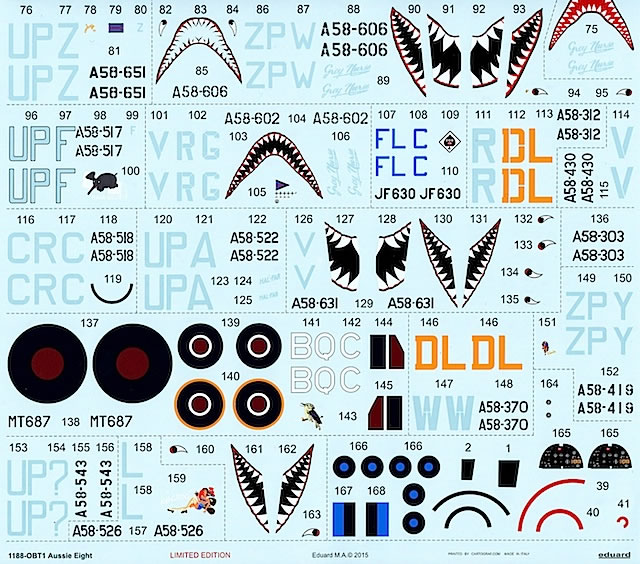
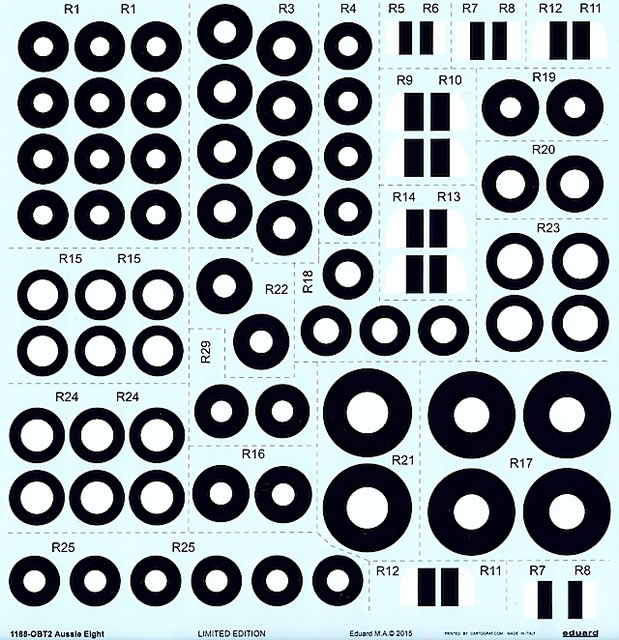
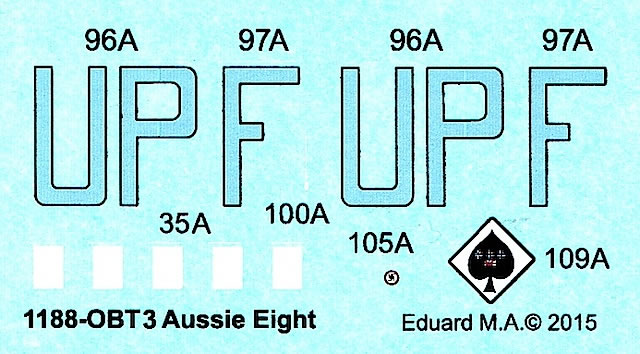

Details are as follows:
-
A58-484/CR-C, flown by Group Captain Clive Caldwell, CO No.80 Wing, Morotai, Netherlands East Indies, March 1945. RAAF Foliage Green and RAF Dark Earth over RAF Azure Blue.
-
A58-411/QY-P/'Betsy', flown by Flying Officer Peter Bullock, No.452 Squadron, Sattler Airstrip, Northern Territory, Australia, September 1944. Foliage Green and Dark Earth over Azure Blue.
-
A58-435/QY-T, flown by Flight Lieutenant William 'Ron' Cundy, No.452 Squadron, Sattler Airstrip, July 1944. Foliage Green over RAAF Sky Blue.
-
A58-477/ZP-Q, flown by Flying Officer Alf Glendinning, No.457 Squadron, Sattler
Airstrip, November 1944. Foliage Green over Sky Blue.
-
A58-513/UP-X/'A.V.B. The 1st', flown by Squadron Leader Ron Susans, CO No.80 Wing, Morotai, June 1945. Foliage Green over Sky Blue.
-
A58-528/CRC, flown by Group Captain Clive Caldwell, CO No.80 Wing, Clark Field, Philippines, March 1945. Foliage Green over Sky Blue.
-
A58-379/ZF-Z, flown by Flight Lieutenant David Glaser, No.549 Squadron, Strauss Airstrip, Northern Territory, September 1944. Overall natural metal with black anti-glare strip.
-
A58-482/TS-V, flown by Squadron Leader David Glaser, CO No.548 Squadron, Darwin Civil Aerodrome, May 1945. Foliage Green and RAAF Dark Sea Grey over RAF Medium Sea Grey (or equivalent local greyish blue).
-
A58-429/QY-V/'Rima III', flown by Squadron Leader Lou Spence, CO No.452 Squadron, Sattler Airstrip, late 1944. Foliage Green over Sky Blue.
-
A58-457/ZP-Z/'Sweet As A Song', flown by Squadron Leader Tom Trimble, CO No.457 Squadron, Sattler Airstrip, late 1944. Foliage Green and Dark Earth over Azure Blue.
-
A58-516/QY-T, flown by Flight Lieutenant Des Cormack, No.452 Squadron, Morotai, December 1944. Foliage Green over Sky Blue.
-
A58-504/QY-R, flown by Flying Officer Rex Watson, No.452 Squadron, Balikpapan, Borneo, August 1945. Foliage Green over Sky Blue.
-
A58-609/ZP-F/'Grey Nurse', flown by Flight Lieutenant Bill Cable, No.457 Squadron, Morotai, February 1945. Foliage Green, RAF Dark Green and RAF Ocean Grey over Medium Sea Grey.
-
A58-651/UP-Z/'Judy III', flown by Squadron Leader Ken James, CO No.79 Squadron, Morotai, May 1945. Foliage Green, Dark Green and Ocean Grey over Medium Sea Grey.
-
A58-606/ZP-W/'Grey Nurse', flown by Squadron Leader Bruce Watson, CO No.457 Squadron, Sattler Airstrip, January 1945. Foliage Green, Dark Green, and Ocean Grey over Medium Sea Grey.
-
A58-606/ZP-W, flown by Squadron Leader Bruce Watson, CO No.457 Squadron, Labuan, Borneo, August 1945. Foliage Green, Dark Green and Ocean Grey over Medium Sea Grey. Note that – amongst a number of minor changes to A58-606's previous finish – the name 'Grey Nurse' is now missing.
-
A58-517/UP-F/'Hava-Go-Jo!!', flown by Flying Officer Norm Turnbull, No.79 Squadron, Morotai, April 1945. Ocean Grey and Dark Green over Medium Sea Grey with white tail surfaces and wing leading edges.
-
A58-602/RG-V/'Grey Nurse', flown by Wing Commander Bobby Gibbes, Wing Leader No.80 Wing, Sattler Airstrip, December 1944. Foliage Green, Dark Green and Ocean Grey over Medium Sea Grey.
-
JF630/FL-C, flown by Flying Officer Larry Cronin, No.81 Squadron, RAF, Palel, India, 6 March 1944. Dark Earth and RAF Middle Stone over Azure Blue.
-
A58-312/DL-R, flown by Flight Lieutenant D.M. Gossland, No.54 Squadron, Truscott Airstrip, Western Australia, July 1944. Dark Earth and Foliage Green over Azure Blue.
-
A58-430/QY-V, flown by Flying Officer Jack King, No.452 Squadron, Tarakan, Borneo, July 1945. Foliage Green over Sky Blue.
-
A58-518/CR-C, flown by Flying Officer Jack Pretty, No.452 Squadron, Morotai, December 1944. Foliage Green over Sky Blue.
-
A58-522/UP-A/'Hal-Far', flown by Flight Lieutenant Len Reid, No.79 Squadron, Morotai, March 1945. Dark Green, Foliage Green and Ocean Grey over Medium Sea Grey.
-
A58-631/ZP-V/'Grey Nurse', flown by Flight Lieutenant George Scrimgeour, No.457 Squadron, Labuan, Borneo, June 1945. Dark Green, Foliage Green and Ocean Grey over Medium Sea Grey.
-
A58-303 of No.1 APU, Laverton, Victoria, Australia, late 1944. Overall natural metal with white tail surfaces and wing leading edges.
-
A58-370/DL-W, No.54 Squadron, Darwin Civil Aerodrome, May 1945. RAAF Dark Earth and probably RAAF Light Earth over Azure Blue.
-
MT687/BQ-C, No.451 Squadron, Cuers airfield, France, September 1944. Dark Green and Ocean Grey over Medium Sea Grey.
-
A58-526/UP-L/'Avagrog', No.79 Squadron, Morotai, May 1945. Dark Green, Foliage Green and Ocean Grey over Medium Sea Grey.
-
A58-543/UP-?, flown by Warrant Officer Hubert Eccleston, No. 79 Squadron, Morotai, May 1945. Dark Green, Foliage Green and Ocean Grey over Medium Sea Grey with white tail surfaces and wing leading edges.
-
A58-419/ZP-Y/'Blondie', flown by Flying Officer Fred Inger, No.457 Squadron, Sattler Airstrip, October 1944. Foliage Green over Sky Blue.
-
A58-602/RG-V/'Grey Nurse', flown by Wing Commander Bobby Gibbes, CO No.80 Wing, Morotai, April 1945. Foliage Green, Dark Green and Ocean Grey over Medium Sea Grey.
I’m not sure how to sum up ‘Aussie Eight’, given the number of superlatives I’ve already used in this review. I think I’ll just say that if you have any interest at all in Spitfires, the RAAF, or both, then buy this release before it inevitably sells out. You won’t be disappointed. Very highly recommended.
Thanks to Eduard for the sample
Review Text and Images Copyright © 2015 by Brad Fallen
Page Created 9 October, 2015
Last updated
9 October, 2015
Back to HyperScale Main Page
Back to Reviews Page

|
